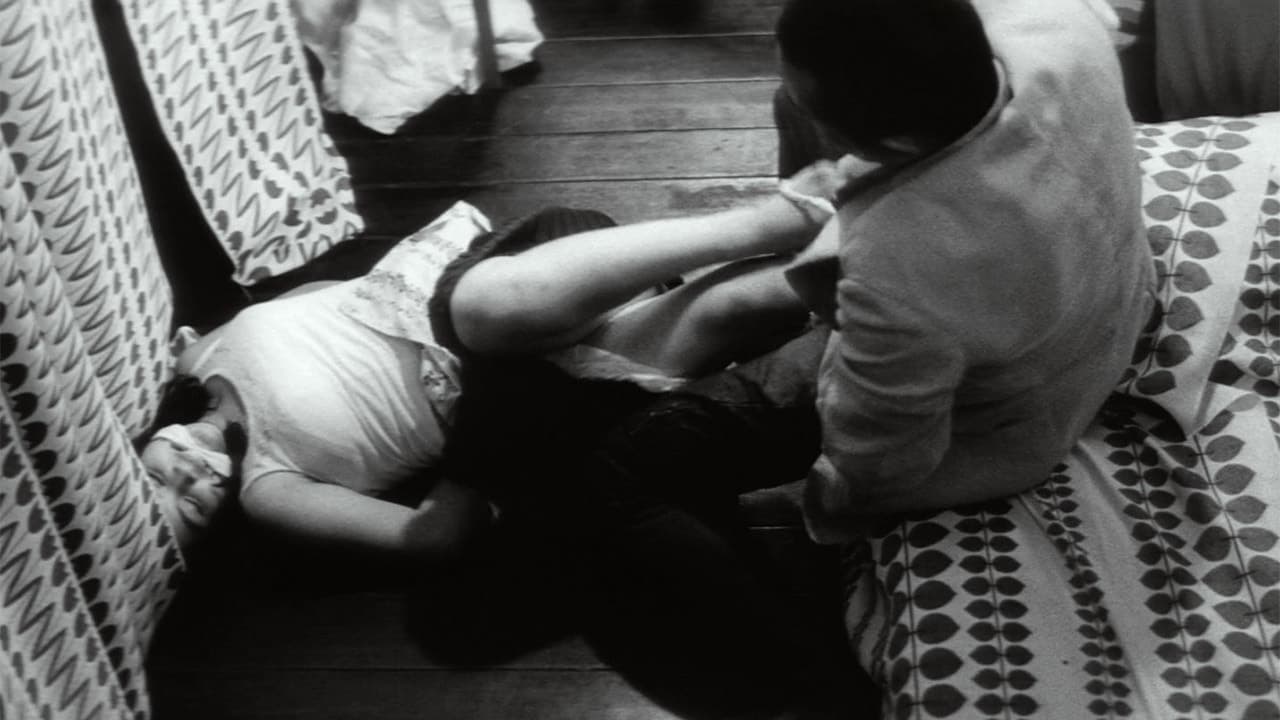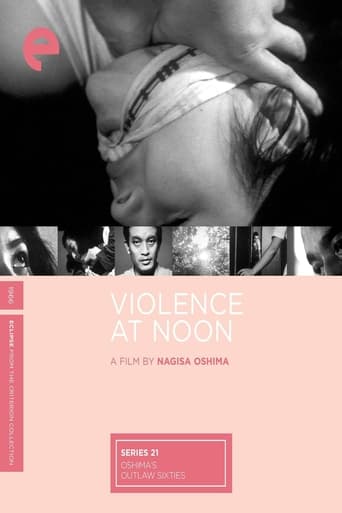

After Pleasures of the Flesh (1965), Violence at Noon (1966) is the second Nagisa Oshima film to based on a work of literature, this time on Tsutomu Tamura's novel which was in turn inspired by actual crimes that took place in a Japanese rural community. The movie adaptation is a strong stylistic departure from many of Oshima's previous (and subsequent) films.The story itself is very bleak and distressing, but always captivating. It focuses on a few characters with questionable motivations and uncertain fates. Due to being linked with a murdering rapist, their lives take a turn for the worse, casually discussing suicide and pondering on their heavy situation, their philosophy of love seeking no rewards now being put to test. The story is non-linear and characterized by sudden leaps between flashbacks and current time. Despite this, the movie is miraculously easy to follow and never becomes confusing, even if we consider the break-neck editing style which sees over 2000 cuts throughout the duration of the film. It disorients the viewer, but at the same time keeps your attention.The film is inspired by the French nouvelle vague, as made evident by the film's title card which pops up randomly several times during the intro like it's a Godard film. The music is great and the B&W cinematography is fantastic, always finding new ways to focus on the close-ups of Saeda Kawaguchi's gorgeous face and to justaxpose the characters' worried faces with the grayish environment. All in all, a fantastic movie.
... View MoreViolence at Noon looks at one men and two women, but it's certainly not a love triangle, at least in any 'normal' sense. The director, the iconoclast Nagisa Oshima, takes a decidedly non-linear approach to this story of a rapist and murderer who has ties to two women, one he raped many years before and his wife (or ex-wife perhaps).I actually DID feel confused a lost a couple of time during the film, but only in the first half. It did jump around a lot, but after a certain point I clicked into Oshima's fast-paced rhythm (and it has about 2,000 cuts so that is a lot even by today's standards), and it has such a fiery sense of what is right and wrong and how the gray areas of the world just take over, and also how a rapist and murder can be understood, if certainly not "liked" at all. It's a dynamic, angry character, simmering and volatile, and when he's on screen you can't take your eyes off him (and it makes for one of the really great openings to any movie, as he enters a house and eyes a woman, a very dangerous-sexy scene).I really got engrossed in this story of suicide, regret, guilt, and what happens when enveloped in society - that it's a murder mystery is so secondary a note, maybe even the last thing on Oshima's mind. In fact if it hadn't been for a scene on a train that is just shot very clumsily and pretentiously, it might be close to being a perfect "art" film, where a director takes some major chances with style and effect to tell his story. As it stands, I was drawn into Violence at Noon through the emotionally harrowing performances and the innovative editing (and even among other "New Wave" filmmakers of the era who used editing to unconventional effect this had an uncanny sense of going back and forth in time - taking on memory as snapshots, but still cohesive for a full story).
... View MoreI bought a rare copy of this for $1 at my local library, being a fan of foreign (especially Japanese) cinema, and never having heard of the director, Nagisa Oshima. I definitely cannot say that the film is bad, because like the reviewer above, I did not understand it. It isn't that I had difficulty following what was happening in the storyline, which was pretty straightforward, but I just had no idea what the intent of the filmmakers were, what the purpose of the story was. The storyline is so bizarre and sensationalistic - a serial rapist and his relationship with both his wife and one of his victims, all three of whom used to be part of some kind of commune for intellectuals (I didn't even know it was a commune until reading another reviewer's synopsis) - that I am sure there must be some underlying symbolism or message here the director was trying to convey. Maybe it had something to do with Japanese society of the time (1966), I'm not sure? Therefore, I must give my opinion of the outward details of the film. The black-and-white cinematography of the film was exquisite, and the constant cutting of shots from scene to scene was highly impressive. It is obvious a great deal of energy and resources were put into the production. This film is outwardly exceedingly beautiful, on a par with other such visual Japanese films as "Kwaidan" and "Kagemusha." The music score was arresting, as well. Other reviewers all seem to compare this to the work of French director Alain Resnais, but I have never seen any of his films. To me, the film seemed distantly related to the works of Stanley Kubrick in its meticulous attention to visual compositions (I saw the film in widescreen, and I can't even imagine watching it in full screen) and its delving into very dark, uncharted psychological territory. Another film to compare this to is Nicholas Roeg's "Bad Timing: A Sensual Obsession" - another dark, non-linear, visually beautiful film whose themes were very difficult to penetrate. The other major drawback is the length - this film does seem to go on about a half hour too long.I would love to have a conversation with the director on just what the storyline means, but unfortunately, I had to watch it without any frame of reference. That made it a frustrating intellectual experience, but an impressive aesthetic one.
... View MorePossibly the most confusing movie I've ever sat through, it took me a long time to get anything out of it. I just couldn't grab onto even the slightest shred of a plot, and, without the ability to find a hook, it felt at first like watching a blank wall. But eventually, I started making inroads and, as the film progresses, its chopped-up plot begins to emerge. It is the story of a rapist and murderer and two women with whom he is intricately involved. Shino is one of his rape victims, and also, we find out, a woman he rescued from suicide in the past. Jinbo is the killer's wife, who knows his guilt (or at least suspects it) but loves him and wants to protect him. Nagisa Oshima actually went to film school in France, and, though part of the Japanese New Wave, no one will miss the French New Wave influences, especially Alain Resnais, whose films have similarly infuriated me in the past with their difficult narratives. Even if I never understood what the hell happened here, the film has several great aspects. The acting is quite good, that's clear. But, in particular, the music, by Hikaru Hayashi, and the cinematography, by Akira Takada, are extremely beautiful. I think I might like this one better if I give it yet another try.ETA: zetes here in the distant year 2010, having just watched the film for the second time. It seems that younger zetes was being a tad dumb, though it could have been the fact that he watched it on a VHS with probably washed-out subtitles (remember those? Yeah, I don't miss them!). The film is actually kind of convoluted, perhaps purposely so. But after the first third of the film, it's fairly clear what's going on. It is quite good, and the visuals and direction are spectacular. This is now available on DVD in an Eclipse box set (it's generally considered to be the best film in that set, too, though I've only watched a couple of films from it so far).
... View More